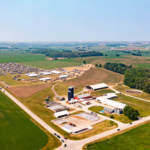
The dairy industry is a significant contributor to global greenhouse gas (GHG) emissions, particularly methane (CH₄) from enteric fermentation and manure management. Developing carbon projects in this sector can reduce emissions and generate carbon credits while promoting sustainable dairy farming practices. Below is a brief guide for developing carbon projects in the dairy industry.
Envirowise can help you in carbon project development from initial design to final carbon credit issuance.
- Identify Project Opportunities
Dairy-related carbon projects typically focus on the following areas:
- Manure Management: Install anaerobic digesters to capture methane for energy generation.
- Enteric Fermentation: Improve livestock diets to reduce methane emissions.
- Renewable Energy: Replace fossil fuels with biogas or other renewable energy sources.
- Energy Efficiency: Improve the energy efficiency of dairy operations.
- Land Use and Feed Production: Implement sustainable agricultural practices, such as rotational grazing or cover cropping, to enhance soil carbon sequestration.
- Baseline Assessment
- GHG Inventory: Calculate the current emissions from dairy operations, including methane, nitrous oxide (N₂O), and CO₂.
- Emission Sources: Identify the primary sources, such as manure, feed production, and energy use.
- Baseline Scenario: Establish what emissions would occur without the project intervention.
- Feasibility Study
- Technical Feasibility: Assess technologies or practices required for emission reductions, such as biogas systems or feed additives.
- Economic Feasibility: Analyze project costs, potential revenue from carbon credits, and savings from improved efficiency.
- Regulatory Feasibility: Confirm compliance with local and national environmental and agricultural regulations.
- Stakeholder Engagement
- Identify stakeholders, including dairy farmers, local communities, regulators, and supply chain partners.
- Conduct consultations to ensure stakeholder buy-in and address potential concerns.
- Develop a grievance redress mechanism.
- Choose a Carbon Standard
Select an appropriate carbon standard based on the project scope and goals, such as:
- Gold Standard: Ideal for projects with social and environmental co-benefits.
- Verified Carbon Standard (VCS): Suitable for large-scale industrial or agricultural projects.
- Climate Action Reserve (CAR): Focused on North American projects, including livestock methane reduction.
- Methodology Selection
Use an approved methodology for the specific project type, such as:
- AMS-III.D.: Methane recovery in animal manure management systems.
- VM0032: Methodology for sustainable agricultural land management (SALM).
- ACM0010: GHG emission reductions from manure management systems.
- Develop a Project Design Document (PDD)
The PDD is a comprehensive document detailing the project’s design and expected outcomes, including:
- Project Description: Location, scope, and objectives.
- Baseline and Project Emissions: Detailed calculations of emission reductions.
- Monitoring Plan: Data collection methods and parameters.
- Environmental and Social Impacts: Analysis of risks and mitigation measures.
- Validation and Registration
- Submit the PDD to an independent validator accredited by the chosen carbon standard.
- Address any issues raised during validation.
- Register the project with the carbon standard after approval.
- Implementation
- Install or adopt the necessary technologies or practices, such as anaerobic digesters, improved feeding regimens, or renewable energy systems.
- Train dairy farmers and staff on new practices and technologies.
- Monitoring, Reporting, and Verification (MRV)
- Monitoring: Collect data on manure handling, feed use, energy consumption, and emission reductions.
- Reporting: Compile monitoring data into periodic reports for submission to the verifier.
- Verification: Engage an independent auditor to verify the emission reductions.
- Issuance of Carbon Credits
- After verification, carbon credits are issued by the chosen standard.
- Credits can be sold on voluntary carbon markets or through compliance programs.
Co-Benefits
In addition to GHG reductions, dairy carbon projects can provide:
- Improved farm profitability through energy savings and carbon credit revenue.
- Enhanced soil fertility from digestate (byproduct of biogas systems).
- Better air and water quality from improved manure management.
- Social benefits, such as job creation and improved community health.
Challenges
- High Upfront Costs: Technology installations like digesters can be expensive.
- Knowledge Gaps: Farmers may lack expertise in carbon accounting or new technologies.
- Market Access: Selling carbon credits requires understanding market dynamics.
Conclusion
Carbon projects in the dairy industry offer significant potential to reduce emissions while promoting sustainable farming. By aligning technical interventions with carbon standards and stakeholder needs, these projects can create environmental, economic, and social benefits.
Envirowise can help you in carbon project development from initial design to final carbon credit issuance.
